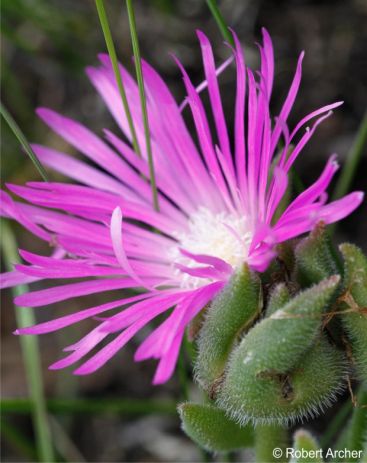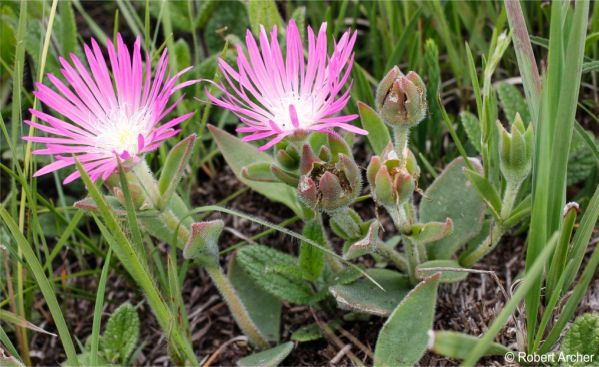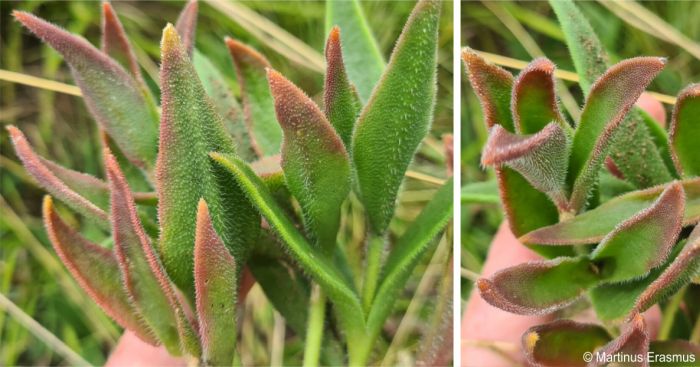Delosperma sutherlandii
Delosperma sutherlandii (Hook.f.) N.E.Br.
Family: Aizoaceae
Common names: Sutherland’s ice plant, fire sheepfig (Eng.); Sutherland-se-vygie (Afr.)
Introduction
Delosperma sutherlandii is a drought-tolerant perennial succulent with fleshy green foliage, and bright purple flowers in spring and summer. It is a ground cover plant that stabilizes soil on slopes and controls soil erosion by its dense spreading growth habit. Through its bright purple flowers, it attracts bees and butterflies to the garden.

Fig. 1. Delosperma sutherlandii has hairy leaves and purple flowers.
Description
Description
Delosperma sutherlandii is a mat-forming, evergreen perennial with small fleshy, dark-green leaves. It has several annual main branches to 200 mm high, from a persistent woody root, and herbaceous parts are covered by short rigid hairs. The internodes are terete and slightly tapering. Leaves are flat, ovate to oblong, tapering to a slender point, 50-80 mm long, with hairs over the entire surface, or only along the margins. Flowers are large, purple to pink, from late spring into mid-summer. Pedicels are up to 2 mm long and are covered with hairs. Petals are pale to bright purple with white filamentous staminodes and pale-yellow anthers. Fruits are capsules with rims recurved along their upper rim, base of fruits is broadly funnel-shaped, with long hairs like the pedicels, the expanding sheets merging into the expanding keels, valve wings rectangular about as broad as the expanding keels.

Fig. 2. Delosperma sutherlandii plant with mature fruits.
Conservation Status
Status
The current conservation status of this species is Least Concern (LC) according to the Red List of South African Plants. Population trend is stable, however, the increase in mining and numerous other environmental and human impacts could threaten the species.

Fig. 3. Delosperma sutherlandii in flower and with developing fruits, in habitat.
Distribution and habitat
Distribution description
Delosperma sutherlandii is widespread throughout the central parts of the summer-rainfall region of southern Africa. In South Africa it is distributed in the provinces Gauteng (Heidelberg), KwaZulu Natal, Free State and Mpumalanga (Carolina, Ermelo, Lydenburg). It is drought tolerant and ideal for a ground cover in full sun in a rocky or mixed succulent garden bed.

Fig. 4. Delosperma sutherlandii leaves, showing red margins and tips.
Derivation of name and historical aspects
History
The name Delosperma is derived from the Greek words delos, which means ‘evident’, and sperma, which means seed, referring to the seed capsules which have exposed seeds when the capsules are open. Mesembryanthemum sutherlandii Hook.f. is a synonym of Delosperma sutherlandii. A specimen of this species was collected in 1870 by Dr Peter Cormac Sutherland (1822–1900), Surveyor-General of the Colony of Natal, and sent to the Royal Botanic Gardens, Kew, where it was determined by the botanist Joseph Dalton Hooker to be a new species, and he named it after the collector.
Delosperma is a genus of around 170 species of succulent plants formerly included in the genus Mesembryanthemum in the family Aizoaceae. It was established by an English botanist N.E.Brown, in 1925. Aizoaceae or fig-marigold family, sometimes referred to as vygies in South Africa and New Zealand, is a large family of dicotyledonous flowering plants containing 135 genera and about 1 800 species.
Ecology
Ecology
Pollination in this genus is complex and many visitors have been observed. Delosperma sutherlandii has purple-pink flowers that provide potential food to the pollinators and their leaves are very sweet. Delosperma sutherlandii can survive drought and require little care. It may be susceptible to mealybugs and aphids attacks.

Fig. 5. Delosperma sutherlandii leaves and flowers.
Uses
Use
Delosperma sutherlandii has a distinctive frosted appearance. It is a vibrant ground cover that prevents erosion and attracts pollinators. It is drought resistant, thrives with minimal water, and is eco-friendly, making it a top-tier choice for water-wise gardening. It is used as a house plant and sold in nurseries.
There are no recorded medicinal or cultural uses for Delosperma sutherlandii, but plants in this genus are known to be used as good luck charms in KwaZulu-Natal. Some plants in the closely related genus Mesembryanthemum are used in various regions around the world to treat different health conditions, for example, applying juice from the leaf of Mesembryanthemum crystallinum (Common Ice Plant), directly onto oral sores can aid in the healing process, and extract from the plant is used in sunscreens and ointments for sunburn to protect the skin from harmful ultraviolet rays and aid in the healing of damaged skin. Mesembryanthemum crystallinum leaves are also known to be edible.
Growing Delosperma sutherlandii
Grow
Delosperma sutherlandii is propagated by stem cuttings or by sowing the seeds and is frequently grown as a houseplant indoors in cooler temperate regions. It can be planted in coastal gardens, gravel gardens, beside patios and in containers, in rock gardens, on banks and slopes. Its dark grey-green leaves, bright magenta flowers in summer and mat-forming habit, make it a good ornamental ground-cover plant.
Growing conditions can be well-drained loamy or sandy soil of acid, alkaline or neutral pH. When growing in pots, the growing medium must not retain too much moisture. Plant it in a hole that is the same depth as the existing root system. Pot grown plants can be planted at any time, but spring is the best time, rather than summer, to plant them out in the garden. They also fare well in a gravel garden. It requires as much sunlight as possible, so it should be positioned in full sun. No pruning is required.
Common problems related to growing Delosperma sutherlandii is overwatering or poor drainage since waterlogging can cause rotting. This plant is generally disease free but may be susceptible to mealybugs, aphids and other common pests.
References
- Archer, R. 2015. Observation of Delosperma sutherlandii, Belfast, Mpumalanga. iNaturalist. Online. https://www.inaturalist.org/observations/11160342.
- Archer, R. 2016. Observation of Delosperma sutherlandii, Steenkampsberg, Mpumalanga. iNaturalist. Online. https://www.inaturalist.org/observations/11203747.
- Bolus, H.M.L. 1928. Mesembryanthemum and some allied genera Part 2. University of Cape Town, Bolus Herbarium.
- Burgoyne, P. 2005. Delosperma N.E.Br. (Aizoaceae). PlantZAfrica. Online. https://pza.sanbi.org/delosperma.
- Burtt Davy, J. 1926. A manual of the flowering plants and ferns of the Transvaal with Swaziland, South Africa. Longmans, Green and Co. Ltd., London.
- Buys, M.H., Janse van Rensburg, L.L., Mienie, C.M.S., Barker, N. & Hartmann, H.E.K. 2008. Applying AFLPs in Aizoaceae: The Delosperma herbeum complex as a case study. Biochemical Systematics and Ecology 36: 92-100.
- Erasmus, M. 2023. Observation of Delosperma sutherlandii, Nkangala, Mpumalanga. iNaturalist. Online. https://www.inaturalist.org/observations/148814278.
- Germishuizen, G. & Meyer, N.L. (eds) 2003. Plants of southern Africa: an annotated checklist. Strelitzia 14. National Botanical Institute, Pretoria.
- Hammer, S. & Barnhill, C. 1997. Odes Part Two: Description of New Mesembryanthema. Bradleya 15: 42-47.
- Ncaphayi, S. 2019. Mesembryanthemum crystallinum L. (Aizoaceae). PlantZAfrica. Online. https://pza.sanbi.org/mesembryanthemum-crystallinum.
- netmeds.com. Ice Plant: Uses, Nutrition, Recipe and Health Benefits Of This Leafy Green. https://www.netmeds.com/health-library/post/ice-plant-uses-nutrition-recipe-and-health-benefits-of-this-leafy-green. Accessed 08/05/2024.
- Niemandt, C. 2023. Observation of Delosperma sutherlandii, Nkangala, Mpumalanga. iNaturalist. Online. https://www.inaturalist.org/observations/165106705.
- North Carolina Extension Gardener Plant Toolbox. Delosperma sutherlandii. https://plants.ces.ncsu.edu/plants/delosperma-sutherlandii/. Accessed 29/07/2024.
- Plug, C. 2020. Sutherland, Dr Peter Cormac. S2A3 Biographical Database of Southern African Science. Online. https://www.s2a3.org.za/bio/Biograph_final.php?serial=2766.
- Pooley, E. 2003. Mountain flowers, a field guide to the flora of the Drakensberg and Lesotho. Natal Flora Publications Trust, Durban.
- Raimondo, D., Von Staden, L., Foden, W., Victor, J.E., Helme, N.A., Turner, R.C., Kamundi, D.A. & Manyama, P.A. (eds) 2009. Red list of South African plants. Strelitzia 25. South African National Biodiversity Institute, Pretoria.
- Tavistock, S. & Covent, G. 1925. Gardeners’ Chronicle. A weekly illustrated journal of horticulture and allied subjects 78(3).
- Waddington, E. 2023. Delosperma ‘Ice Plant’. Horticulture Magazine. Online.https://horticulture.co.uk/delosperma/. Accessed 23/07/2024.
- Walton, A. 2019. Observation of Delosperma sutherlandii, Vryheid-Ladysmith, KwaZulu-Natal. iNaturalist. Online. https://www.inaturalist.org/observations/22144587.
Credits
Murendeni Kwinda
National Herbarium, Pretoria
October 2024
Acknowledgements: the author thanks Prof Ramagwai Joseph Sebola and Alice Notten for editing this article, and Anthony Walton, C. Niemandt, Martinus Erasmus and Robert Archer for making their images available via iNaturalist.
Plant Attributes:
Plant Type: Succulent
SA Distribution: Free State, Gauteng, KwaZulu-Natal, Mpumalanga
Soil type: Sandy, Loam
Flowering season: Spring, Early Summer, Late Summer
PH: Acid, Alkaline, Neutral
Flower colour: Purple, Pink
Aspect: Full Sun
Gardening skill: Easy
Special Features:
Horticultural zones









Rate this article
Article well written and informative
Rate this plant
Is this an interesting plant?
Login to add your Comment
Back to topNot registered yet? Click here to register.